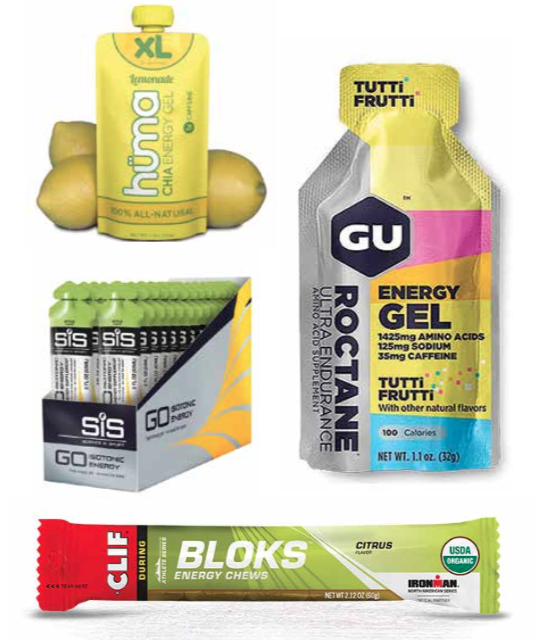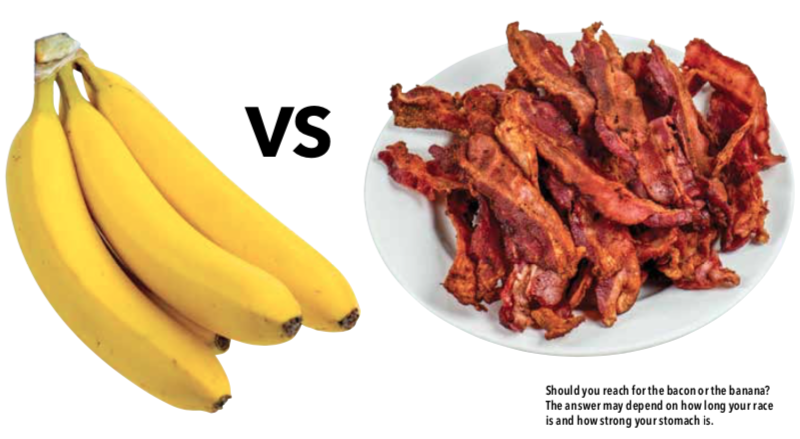What to Eat (And What Not To) During Your Marathon
What’s at that aid station coming up? Here’s a nutritionist’s guide to what to go for and what to skip if you want to add power to your run or ride.
Bacon!” If you had asked me the morning of the Kalamazoo Marathon what I would be thinking as I reached the halfway point, I can guarantee it would not have been “bacon.”
Yet as I heard the satisfying beep from my watch confirming that I had logged 13 miles, that is exactly what came to mind. I thought my eyes must be deceiving me as I witnessed a six- foot-tall strip of bacon dancing in the street ahead of me. Could this possibly be a hallucination? No, this was the fanfare that awaited all the racers at the Kalamazoo Marathon’s official “Bacon Station.” That’s right—an aid station serving up strips of bacon to runners. Now that’s commitment.
Sports drinks, gels and gummies are pretty standard fare at most races. But bacon? Although it smelled delicious, the thought of running another 13.1 miles with a stomach full of bacon was enough to cause my stomach to churn.
Still, what about the other random and sometimes unconventional foods that races or spectators offer up to runners? Just call me the “diet detective” as I take a closer look at what race foods you might run across (pun intended) and whether they could fuel you to a strong finish or leave you making a beeline for the bathroom.
Bacon: The aroma of sizzling bacon may be hard to pass up, but unless you’re competing in an ultramarathon, bacon won’t provide the quick energy needed for shorter and faster races. Bacon packs in plenty of fat and protein, but with no carbohydrates to speak of, it takes a long time to digest and thus provides no readily accessible energy.
Bananas: Bananas and running are hardly a novel pairing. Many races distribute bananas as a natural food option, meant to provide energy and stave off cramps. Studies comparing ingesting bananas versus sports drinks have found that bananas provide similar benefits in terms of endurance performance. In fact, bananas beat out sports drinks in reducing exercise- induced inflammation. That being said, researchers have noted that the ideal rate of consumption (half of a banana every 30 minutes) is largely impractical and results in significant bloating. This makes bananas a good option as a complement to your other fuel choices, but not a good option as an exclusive fuel source. Another tricky element: the ripeness factor. Riper bananas contain more simple sugars whereas greener bananas are higher in starch. Simple sugars are the way to go while running so if you opt for bananas, be choosy when you approach an aid station.
Beer: Enthusiastic spectators routinely offer up a beer long before it’s time to truly celebrate a successful race finish. In case you’re considering getting your post-race party started early, think again. Contrary to popular belief, beer isn’t loaded with carbs. In fact, one can of beer only contains approximately 13 grams of carbohydrates and light beers even fewer with about 7 grams. And from a hydration standpoint, studies have shown that the alcohol content of beer must be less than 4% by volume or the dehydrating affects of alcohol offset the fluid taken in. Few beers clock in that low. Also be aware that carbonation can be tough on even those with an iron stomach.
Chocolate: It seems only fitting that the Hershey Half Marathon has a chocolate aid station on, of all places, Chocolate Avenue. One Hershey’s chocolate bar provides 44 grams of carbohydrate, putting it in the range of what an endurance runner should consume in an hour. Unfortunately, those “carbs” also come with a lot of fat that can delay digestion time. So instead of a quick hit of sugar, you are more likely to end up with a stomach cramp. Save the chocolate for after the race in the form of chocolate milk to get the carbs and protein needed to optimize recovery.
Gummy Bears: Sure they’re cute, but can they help you power through a race? Composed mostly of sugar, one serving will provide you with the recommended 30 grams of carbohydrate. The major negative is their lack of electrolytes. Other candies that are routinely passed out such as Twizzlers and Swedish Fish fall into the same boat. However, as long as you are smart about supplementing with other fuel sources that contain electrolytes, then there’s no harm in giving in to a candy craving.
Maple syrup: This Vermont staple has recently caught on as a popular fueling option for endurance sports. Companies like Vermont’s own UnTapped sell it in packaging similar to other gels with an option that includes added caffeine. Spectators at the Vermont City Marathon routinely hand out “shots” of syrup to runners and at May’s Middlebury Maple Run, maple syrup goes to every finisher. Maple syrup delivers on a quick hit of sugar, but is lacking in electrolytes so be sure to also use an electrolyte replacement if you are fueling yourself off syrup.
Orange wedges: A hit of citrus may be just what you need to provide some hydration even if oranges don’t fully deliver on carbs. One orange delivers 15 grams of carbohydrates so one wedge won’t make a big dent in your fueling needs. However, oranges are packed with vitamin C, which acts as a powerful antioxidant that can help reduce post- exercise muscle soreness.
Pretzels: Even those with a sweet tooth can find themselves craving something salty midway through a race. Fortunately, pretzels aren’t a bad option considering what they offer up. Normally, refined carbohydrates would be a negative for nutrition, but during runs the low fiber content makes those carbohydrates easier to digest and absorb. Pretzels also pack plenty of sodium for hot weather when you’re likely to lose sodium through sweat.
Watermelon: Chunks of this summertime snack staple are regularly handed out in warm weather races. In addition to its high water content, another perk of consuming watermelon is its significant concentration of L-citrulline. Studies have shown that L-citrulline can improve aerobic performance and reduce post-exercise muscle soreness. However, at 90% water, one cup of watermelon has only 11 grams of carbohydrate. Consuming at least three cups of watermelon per hour while running? Not the most practical option. If you happen to get offered a piece of this tantalizing fruit, just remember that while it won’t hurt you to have a bite, it is better for quenching your thirst than it is at actually providing the energy you need for endurance.

My Top 5 Other Fuels
If the aforementioned fueling options aren’t for you there are plenty of products that should fit the bill. The challenge can be the overwhelming so check out my top five fueling products:
1. Clif Shot Bloks
Many runners who dislike or can’t stomach gels prefer Clif Shot Bloks. I’m a fan because not only do they provide simple sugars and electrolytes, but they also have options with added caffeine to boost performance. Just three pieces provide 24 grams of carbohydrate so you can keep popping these in your mouth for sustained energy intake.
2. GU Energy Gels
Coming in at 23 grams of carbohydrate per gel, GU has the widest array of flavor options with everything from French Toast to Salted Watermelon. GU gels also have varieties with added caffeine, electrolytes and even branch chain amino acids.
3. Huma Chia Energy Gels
The company’s founder based these gels off what the Tarahumara Indians, known for long distance running, fuel off of. They include an all-natural mix of chia seeds, lime juice, fruit puree, evaporated cane juice, coconut water, brown rice syrup and of course chia seeds, plus electrolytes from coconut water and sea salt. With 22 grams of carbohydrates, these gels also deliver on amino acids with the option for added caffeine.
4. Science In Sport (SiS) Go Isotonic Energy Gel
These gels are a great option due to their ideal ratio of carbohydrate to water. This means unlike most gels that need to be consumed with water, SiS gels can be consumed on their own with no cause for concern about digestive distress.
5. Skratch Labs Energy Chews
With 40 grams of carbohydrate per package, these chews use two types of simple sugars to optimize absorption to give you a boost of energy that can power you through long runs. Skratch provides a more natural option by eliminating a lot of the excess ingredients like artificial colors and wax used in many sports snacks.
As the Director of Nutrition at The Edge in Burlington, Jamie Sheahan, M.S., R.D. works closely with athletes to develop customized fueling plans. Sheahan is also an adjunct professor of sports nutrition at UVM and has completed more than 20 marathons.

